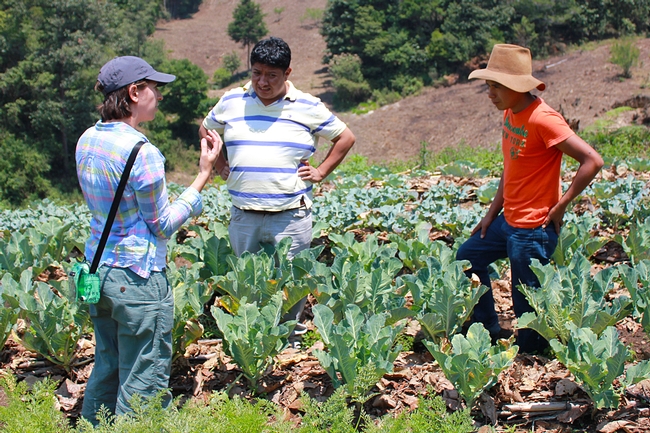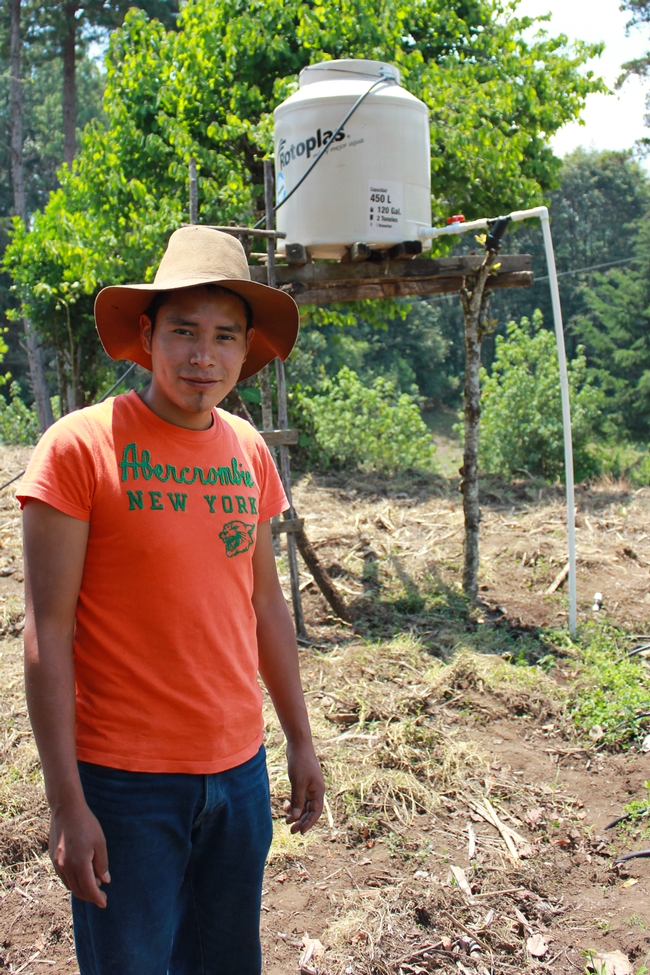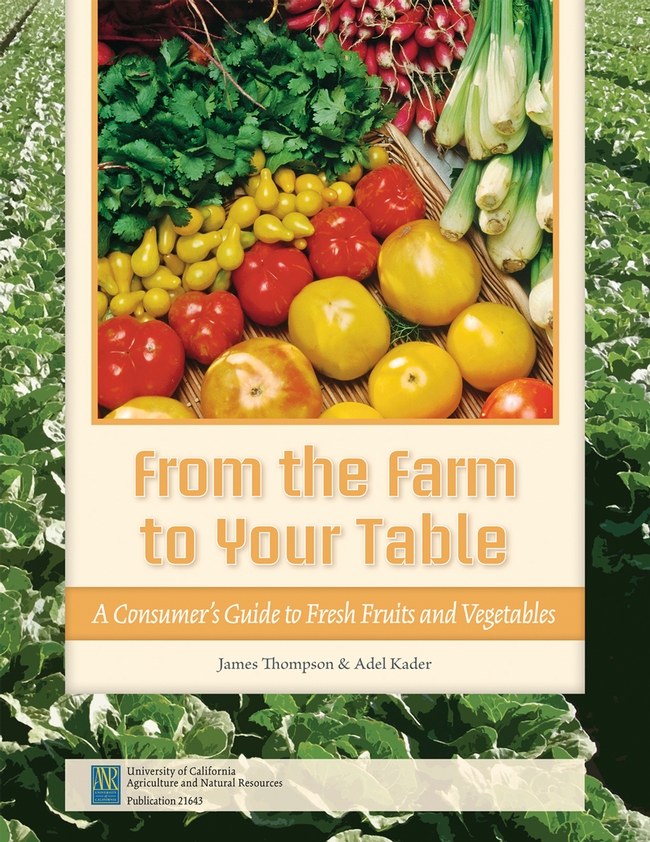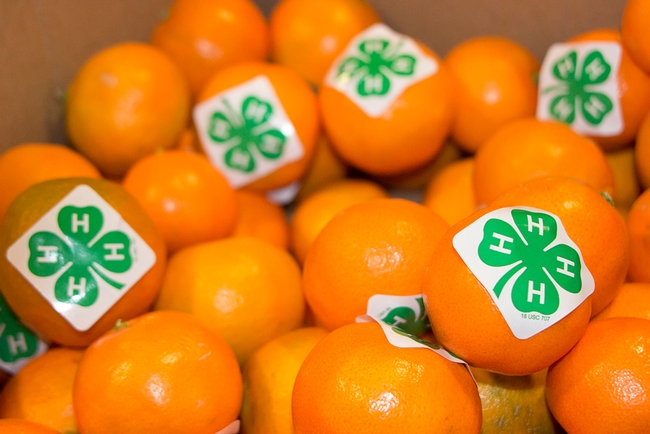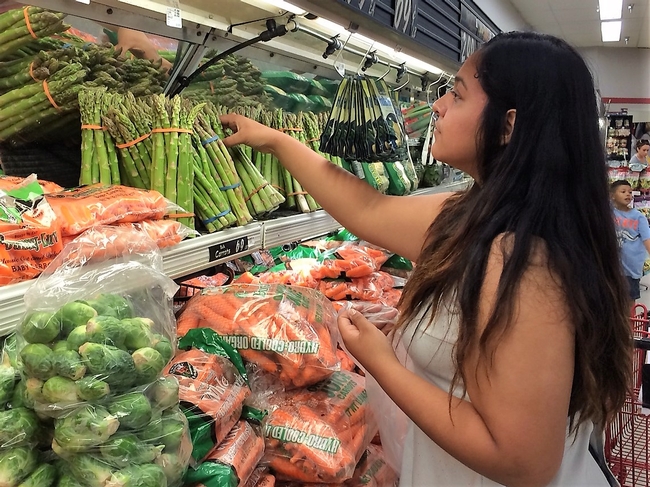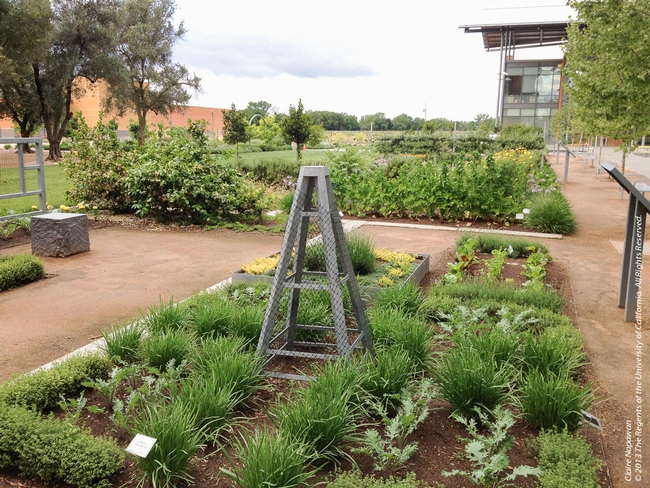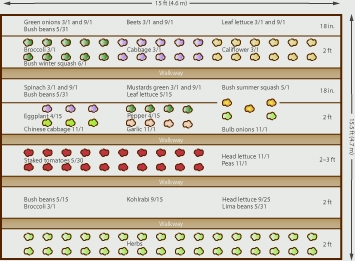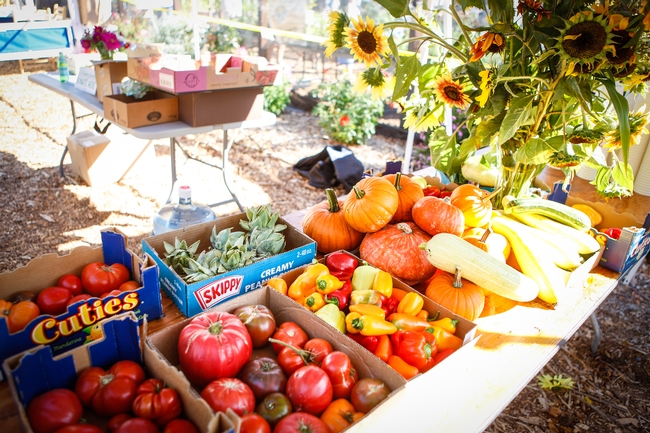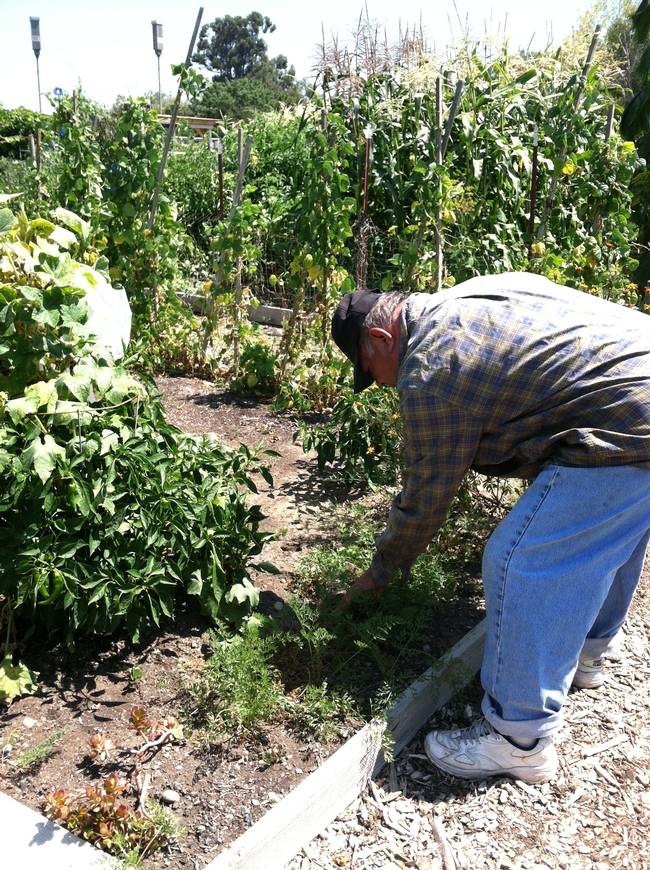Posts Tagged: vegetables
More irrigation for climate-smart farming and food security in Guatemala
Connecting 9,000 rural households in Guatemala with improved water management and climate-smart agriculture strategies is the goal of a new project led by a team at UC Davis, to ultimately increase food security and reduce poverty in Guatemala's Western Highlands.
“The opportunity to impact so many farmers' lives on this scale is exciting,” said Beth Mitcham, director of the Horticulture Innovation Lab and a UC Cooperative Extension specialist in the UC Davis Department of Plant Sciences. “We're taking lessons learned from our previous research — in Guatemala, Honduras and Cambodia — and building a team to help more small-scale farmers apply our findings and successfully use these innovative practices.”
The new project is part of the U.S. government's global hunger and food security initiative, Feed the Future. The project represents an additional $3.4 million investment in the UC Davis-led Horticulture Innovation Lab by the U.S. Agency for International Development's mission in Guatemala.
The project's international team also includes representatives from Kansas State University; North Carolina Agricultural and Technical State University; the Centro de Paz Bárbara Ford in Guatemala; Universidad Rafael Landívar in Guatemala; and the Panamerican Agricultural School, Zamorano, in Honduras.
“The learning shared between these three U.S. universities and the universities in Honduras and Guatemala will be enriching for all of the institutions involved,” said Manuel Reyes, research professor at Kansas State University who is part of the team. “I find it satisfying that these academic institutions will be investing intellectually in marginalized groups in Guatemala's Western Highlands — and in turn, learning from them too.”
Helping youth envision a future in agriculture
By partnering with local youth groups and agricultural schools, the team will better prepare students for jobs in commercial agriculture and agricultural extension with knowledge of climate-resilient conservation and water management practices.
“Our local team is training youth as entrepreneurs, to see agriculture as an economic opportunity instead of just back-breaking work,” said Meagan Terry, UC Davis junior specialist who is managing the project in Guatemala for the Horticulture Innovation Lab. “They can envision a future in agriculture, with innovative ways to create value-added products or grow high-value crops for niche markets.”
As rainfall patterns vary with climate change, farmers in this region are expected to face increased competition for water. Practices such as rainwater harvesting, drip irrigation and conservation agriculture will become more necessary for small-scale farmers.
Climate-smart lessons from conservation agriculture, drip irrigation
In previous research, the Horticulture Innovation Lab has found that combining drip irrigation with conservation agriculture practices can successfully grow vegetables on small plots of land, without significant yield reductions. These practices improve soil structure, moisture retention and soil health.
Additionally, women farmers who participated in the Horticulture Innovation Lab studies in Cambodia, Honduras and Guatemala favored using these practices for another important reason: reduced labor in relation to controlling weeds, vegetable bed preparation and manual watering.
“I dream for many women, youth and their families, that their lives will be better off because of 'MasRiego' and the science behind this work,” Reyes said. “As for the research, we are learning how to improve this suite of practices so they can be tailor fitted globally. I am convinced that if this picks up, steep sloping lands can be farmed with the soil quality not being degraded — but even being enriched.”
These lessons, as well as findings from the program's “Advancing Horticulture” report about horticultural sector growth in Central America, lay the foundation for this new project.
A previous version of this article was published by UC Davis News Service and on the Horticulture Innovation Lab blog.
Curious about partnering with the Horticulture Innovation Lab? The Horticulture Innovation Lab builds partnerships between agricultural researchers in the United States and researchers in developing countries, to conduct fruit and vegetable research that improves livelihoods in developing countries. The program currently has three research grant opportunities for U.S. researchers: one focused on tomatoes, another on apricots, and a third on integrated crop-livestock systems.
Keeping produce at its best
Farmers markets, produce stands, and likely your own backyard garden are an exploding bounty as California strawberries, stone fruits, and tomatoes show the summer produce season is in full swing.
But have you ever wondered what to look for when selecting fruits and vegetables? Why does your refrigerator have separate bins for fruits and vegetables? Should fresh tomatoes be stored in the refrigerator or on the counter? And how do you keep fresh basil fresh until you're ready to use it?
These and many more questions are answered in the colorful handbook: From the Farm to Your Table: A Consumer's Guide to Fresh Fruits and Vegetables available at anrcatalog.ucanr.edu
And now through July 31 the publication is 40 percent off if you order through our online catalog. So you can grab a copy for under $5.
This guide is brimming with tips from the pros at the Postharvest Technology Center at UC Davis. You'll find information on storage and handling for quality and safety as well as handy tables explaining which fruits and vegetables should be stored in the refrigerator and which should be stored on the counter. You'll also learn what to look for when selecting popular produce items for best quality.
And if you've ever wondered the steps your produce takes to get from the field to your market, the journey is explained here.
Oh, and the answers to those questions?
Your refrigerator has separate bins so you can keep keep ethylene gas-producing fruits such as apples, peaches, and pears away from vegetables. The naturally occurring gas can hasten spoilage of vegetables.
Un-cut tomatoes should be stored on the counter, not in the refrigerator.
And keep your basil fresh by treating it as you would cut flowers; place the stems in a glass of water on the counter until you're ready to use it.
Teens put their food smarts to the test
Grocery shopping can be the most anticipated or the most dreaded necessity of daily life. A trip to the market can end with a smile over the thrill of victory from finding great bargains or end with a frown from the agony of defeat over budget anxieties. For most of us, budget is the primary factor in our food experiences. Low budget or no budget is often the culprit that leads to unhealthy food choices.
Armed with nutrition knowledge acquired through the University of California 4-H Food Smart Families program with the UC Kearney Agricultural Research and Extension Center, teens from Parlier High School in Fresno County are teaching Parlier youth ages 8-12 how to get around budget roadblocks on the path to healthy eating. The program uses a “Teens as Teachers” approach, with teens educating younger youth through a series of hands-on, interactive nutrition lessons after school.
Food connections to local agriculture are highlighted through the partnership with the UC Kearney Agricultural Research and Extension Center. The center will host agriculture tours and family nutrition education activities at a Wellness Fair later this month to wrap up the program.
According to recent United States Department of Agriculture studies, nearly 16 million children live in households where they do not have consistent access to food throughout the year.
UC 4-H Food Smart Families empowers families through food knowledge and education to build sustainable solutions that confront food insecurity and improve health. Youth are engaged at a critical age for growing skills and establishing behaviors today that become sustainable, healthy habits for their families and communities tomorrow. Youth learn they can prepare food themselves and parents learn about working together as a family to plan healthy meals.
Teen teachers put their new skills to the test on a recent field trip to the local grocery store. After a store tour and 4-H training on perimeter shopping, unit pricing and the downfalls of impulse buying, they were given a shopping challenge. The goal was to purchase, within the assigned budget, three items from each of the vegetable, fruit, grain, dairy and protein food groups to create healthy meals at home. As the teens had been learning while teaching their younger counterparts, eating healthy on a budget is achievable with a little nutrition education and careful planning.
Thoughtful discussions, and sometimes passionate debates, ranging from whole grain pasta versus whole wheat pasta to the tasty virtues of hummus, mixed with youthful laughter. The teens were pleasantly surprised to discover they had additional budget to spare. Return trips were made to the produce department for more fruit, vegetables and even hummus.
Comments from the teens told the story of their success. “Now I know what my mom has to go through when she's shopping for food,” and “Look at my cart. Food Smart Families is really influencing me!” Who knew grocery shopping could be so much fun?
The USDA Center for Nutrition Policy and Promotion offers these 10 tips for affordable vegetables and fruits:
• Use fresh vegetables and fruits that are in season.
• Check your local newspaper, online and at the store for sales, coupons and specials.
• Plan out your meals ahead of time and make a grocery list.
• Compare the price and number of servings from fresh, canned and frozen forms of the same vegetable or fruit.
• Buy small amounts more often to ensure you can eat the foods without throwing any away.
• For fresh vegetables or fruits you use often, a large size bag is the better buy.
• Opt for store brands when possible.
• Buy vegetables and fruits in their simplest form.
• Start a garden for fresh, inexpensive, flavorful additions to meals.
• Prepare and freeze vegetable soups, stews or other dishes in advance.
Simple steps for preparing, caring for and harvesting a vegetable garden
There are several ways to overcome these gardening pitfalls to help ensure you have a successful warm-season vegetable gardening experience.
Plan, plan and stick with your vegetable garden plan!
Planning is a key component to having a successful vegetable garden, but is frequently forgotten or overlooked. Planning includes selecting an appropriate location for your garden, choosing the correct varieties of crops for your space and developing a garden plan for what you would like to grow.
When selecting a location it is important that the site receives at least eight hours of full sun, is close to a water source (hose, irrigation or hand-watering) and has good soil for optimal growth. Once you have an appropriate location picked out, creating a garden plan will help contribute to your growing success.
Too often the overall size of the garden area and the size of mature plants is not considered. Keep in mind a young plant can become established and quickly overtake a small garden lot, challenging or dominating other plants for resources.
“A well planned garden can provide fresh or preserved vegetables for use year-round. The plan should contain crops and amounts to be planted, dates of planting and estimated harvest, planting location for each crop, specific spacing between rows, and trellising or support required,” according to the California Master Gardener Handbook (see Figure 13.1 on Page 342).
Invest a little time and develop a detailed plan to help guide you on where, which type and how many plants you will need for your space. Your vegetable garden plan will keep you focused while shopping at your local nursery and prevent impulse buys of tempting transplants!
Caring for your vegetable garden
Irrigation is a key component in a successful vegetable garden. Consistent, deep and sufficient watering will produce better tasting and superior quality fruits and vegetables, especially during the hot summer months when it is easy for the soil to quickly dry out.
“As a rule” the handbook says on Page 349, “it will be necessary to irrigate your vegetable garden one to three times a week in summer ... The frequency will be determined by the depth of crop roots, soil texture, and weather conditions. Wet the soil to just beyond the bottom of the root system at each watering.”
Even in a time of drought, vegetable crops require the soil to remain moist during their crop cycle. Poor irrigation practices and infrequent watering will produce smaller yields and poor quality fruits and vegetables.
Weed prevention and maintenance is an important piece in caring for your vegetable garden. Without monitoring and controlling weeds, your crops could quickly become overrun by these pesky unwanted plants. Apply a three- to four-inch layer of organic mulch to discourage the growth of weeds. Prevent weeds by hand-weeding before they become established and go to seed. The UC Integrated Pest Management (IPM) Program has detailed information available on its website about sustainable weed management in the home landscape.
Harvesting (and enjoying) your crop
After all of your hard work, time and dedication growing your warm-season fruits and vegetables remembering when to harvest can be just as important as growing them. UC Davis' Postharvest Technology Center has easy to navigate Produce Fact Sheets to help guide you on when to best harvest your crops.
“To get the most from your vegetables, harvest them when they are at the best stage for eating and store them under conditions that will keep them as close to garden-fresh as possible,” recommends The California Garden Web. “Vegetables will be crisper and cooler when harvested in the early morning.” (cagardenweb.ucanr.edu)
Once harvested don't forget to enjoy the fruits (and veggies) of your labor. Few experiences can compare with the gratification of eating homegrown fruits and vegetables for the first-time!
Learn more with UC Master Gardeners
Interested in learning more about how to grow a thriving edible garden or home landscape? The UC Master Gardener Program has University trained volunteers who are eager to help. Volunteers are available to answer questions about preparing your soil, fertilizing, mulching and more. With local programs based in more than 50 counties across California there is sure to be a workshop or class near you. Visit our website to find your local UC Master Gardener Program, mg.ucanr.edu.
Gardens contribute vegetables, ease hunger among San Jose residents
People who grow their own vegetables in a garden typically consume enough fresh produce to meet the USDA Dietary Guidelines for a healthy diet, according to a recent UC Cooperative Extension survey of San Jose residents.
A diet containing lots of vegetables is lower in calories and higher in fiber and good for our health. Yet, not everyone has easy access to fresh vegetables in the United States.
“Growing vegetables and having a garden is an effective intervention to promote increased vegetable consumption among all Americans,” said Susan Algert, UC Cooperative Extension advisor in Santa Clara County, who conducted the survey. “This is evidence for bringing back popular home gardens or ‘Victory gardens' of the past rather than investing exclusively in SNAP benefits for purchased foods.”
SNAP, the federal Supplemental Nutrition Assistance Program (formerly called food stamps), now allows participants to buy seeds with their benefits, which helps low-income people who want to grow their own veggies, she said.
Vegetable consumption falls well below the U.S. Dietary Guidelines in much of the U.S., particularly among African American, Latino, low educational attainment, and low-income populations.
Algert and fellow UC Cooperative Extension researchers looked at background characteristics, vegetable intake and program benefits of people who cultivated a home garden versus those who participated in a community garden.
“The home gardeners were significantly younger, had lower incomes, were less likely to have completed college and were more ethnically diverse than the community gardeners,” said Algert, who specializes in nutrition. “In other words, the background characteristics of the two groups varied significantly. In spite of these significant demographic differences, both groups increased their vegetable consumption from the garden to the same extent, by about two servings.”
In fact, by supplementing with food from their gardens, both groups met the U.S. Dietary Guidelines for recommended daily servings of vegetables to promote optimal health.
A lack of experience as gardeners didn't affect the results much. Fifty eight percent of the home gardeners reported having less than two years of experience whereas only one-third of community gardeners were novices.
“This study demonstrates that growing fresh vegetables in either a home or community garden setting can contribute significantly to a person's nutritional intake and food security at all income levels by making it a more affordable to maintain a healthful diet,” said Algert. Urban gardeners also experience a number of other benefits including exercise, stress release, and learning about gardening from their peers and mentors.
The study was a partnership with the Parks, Recreation and Neighborhood Services Department of the City of San Jose and La Mesa Verde, a project of Sacred Heart Community Services of San Jose. The UCCE research group worked with the Parks Department to administer a 30 question background survey to 83 community gardeners in four different gardens during April through September 2012. The same survey, slightly modified, was administered to a group of 50 home gardeners participating in Sacred Heart's La Mesa Verde project between September 2013 and April 2014.


